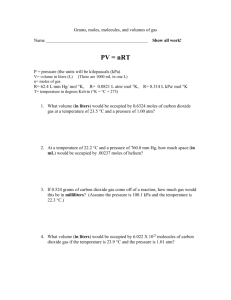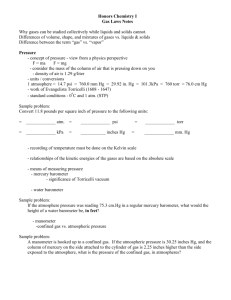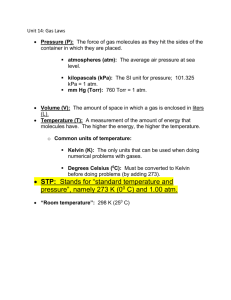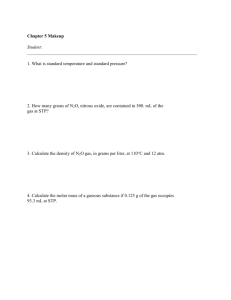PROBLEM SET – GASES - Southington Public Schools
advertisement
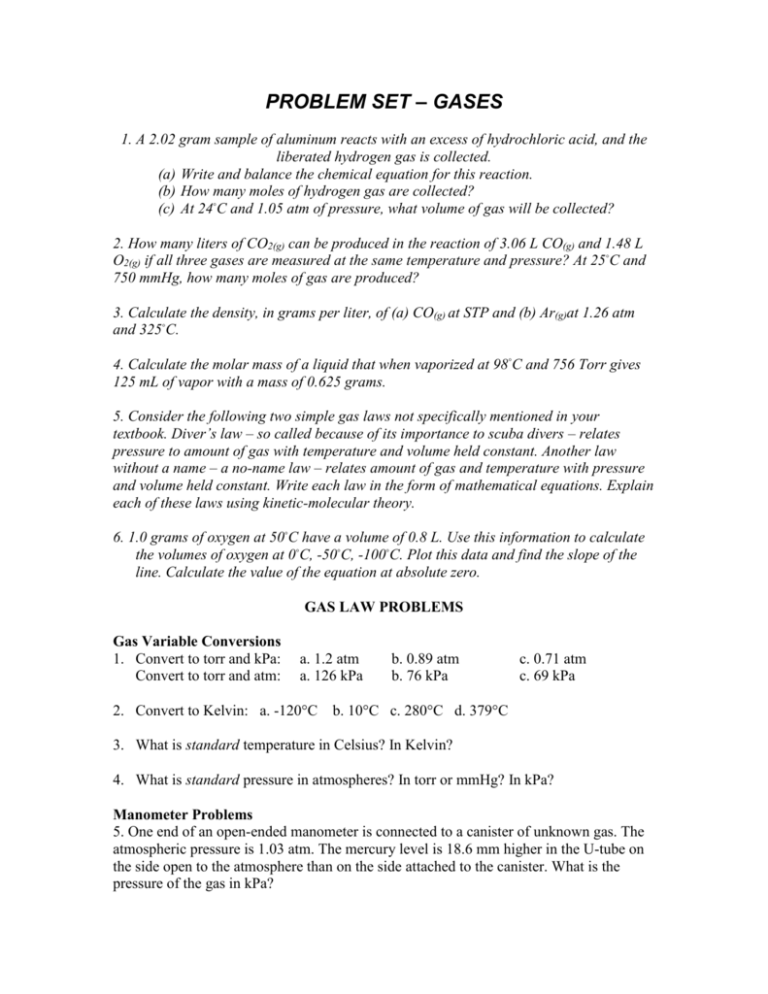
PROBLEM SET – GASES 1. A 2.02 gram sample of aluminum reacts with an excess of hydrochloric acid, and the liberated hydrogen gas is collected. (a) Write and balance the chemical equation for this reaction. (b) How many moles of hydrogen gas are collected? (c) At 24◦C and 1.05 atm of pressure, what volume of gas will be collected? 2. How many liters of CO2(g) can be produced in the reaction of 3.06 L CO(g) and 1.48 L O2(g) if all three gases are measured at the same temperature and pressure? At 25◦C and 750 mmHg, how many moles of gas are produced? 3. Calculate the density, in grams per liter, of (a) CO(g) at STP and (b) Ar(g)at 1.26 atm and 325◦C. 4. Calculate the molar mass of a liquid that when vaporized at 98◦C and 756 Torr gives 125 mL of vapor with a mass of 0.625 grams. 5. Consider the following two simple gas laws not specifically mentioned in your textbook. Diver’s law – so called because of its importance to scuba divers – relates pressure to amount of gas with temperature and volume held constant. Another law without a name – a no-name law – relates amount of gas and temperature with pressure and volume held constant. Write each law in the form of mathematical equations. Explain each of these laws using kinetic-molecular theory. 6. 1.0 grams of oxygen at 50◦C have a volume of 0.8 L. Use this information to calculate the volumes of oxygen at 0◦C, -50◦C, -100◦C. Plot this data and find the slope of the line. Calculate the value of the equation at absolute zero. GAS LAW PROBLEMS Gas Variable Conversions 1. Convert to torr and kPa: Convert to torr and atm: a. 1.2 atm a. 126 kPa 2. Convert to Kelvin: a. -120°C b. 0.89 atm b. 76 kPa c. 0.71 atm c. 69 kPa b. 10°C c. 280°C d. 379°C 3. What is standard temperature in Celsius? In Kelvin? 4. What is standard pressure in atmospheres? In torr or mmHg? In kPa? Manometer Problems 5. One end of an open-ended manometer is connected to a canister of unknown gas. The atmospheric pressure is 1.03 atm. The mercury level is 18.6 mm higher in the U-tube on the side open to the atmosphere than on the side attached to the canister. What is the pressure of the gas in kPa? 6. A manometer contains a sample of nitrogen gas at a pressure of 88.3 kPa. The level of mercury in the U-tube is 12.8 mm lower on the end open to the atmosphere. What is the atmospheric pressure in kPa? Simple Gas Laws/Combined Gas Law 7. A gas occupies 34 mL at 120 kPa. What is the volume at 101 kPa? 8. A gas occupies 12.3 mL at 35°C. What is its volume at 100. °C. 9. A gas has a volume of 3.2 cm3 at 0.95 atm. What is its volume at 1.8 atm? (T is constant.) 10. At what pressure will a gas have a volume of 1.0 liters if it occupies 44 mL at 600 torr? (T is constant.) 11. A gas occupies 4.5 liters at 720 mmHg. At what pressure will its volume be 25 liters. (T is constant.) 12. A gas occupies 56 cm3 at 119°C. At what temperature will its volume be 112 cm3? (Pressure is constant.) 13. A balloon has a volume of 116 mL at 25°C. If it is heat to 35°C, what will its volume be? (Pressure is constant) 14. If a gas occupies 2.1 liters at 30°C, at what temperature will its volume be 1.7 liters? 15. A weather balloon has a volume of 4.8 liters at the surface of the earth, where the temperature is 28°C and the pressure is 754 torr. What will be its volume at 2000 ft, where the temperature is 12°C and the pressure is 700. Torr? 16. A 2.7 mL bubble is formed at the bottom of a pond, where the temperature is 11°C and the pressure is 1.8 atm. What will be its volume when it rises to the surface of the pond, where the temperature is 22°C and the pressure is 0.98 atm? 17. Convert to standard conditions: a. 34 mL of gas at 56°C and 722 torr. b. 7.5 cm3 gas at 190°C and 82 kPa c. 1.2 L gas at 25°C and 1.09 atm 18. A gas occupies 22.4 liters at standard conditions (STP). What will be its volume at 24°C and 750 mmHg? Ideal Gas Law and Applications 19. How many moles of gas occupy a 250 mL flask at 22°C and 0.91 atm? 20. At what temperature will 0.34 moles of gas occupy 2.8 liters if the pressure is 1.3 atm? 21. What is the volume of 0.44 moles of oxygen at 41°C and 0.92 atm? 22. What pressure is needed to compress 0.58 moles of gas into a volume of 2.6 liters if the temperature is 33°C? 23. Find the densities of the following gases at STP: a. CO2 b. CH4 c. Kr d. XeF4 24. Find the densities of the following gases at 27°C and 780 mmHg: b. NO b. CO c. Ne d. PCl3 25. Determine the molar masses of the following gases at 25°C and 1.05 atm: a. density = 1.2 g/L b. density = 2.48 g/L c. density = 3.1 g/L Gas Stoichiometry 26. What volume of oxygen at STP is needed to react with 24 grams of sulfur to produce sulfur dioxide? 27. How many grams of water can be produced from 2.4 Liters of hydrogen reacging with excess oxygen? (Both gases are at STP.) 28. How many liters of oxygen at STP can be produced from 89.6 grams of potassium chlorate? 29. How many grams of mercury (II) oxide must decompose to produce 46 mL of oxygen at STP? 30. How many liters of nitrogen are needed to react with 6.3 liters of hydrogen to produce ammonia (NH3)? 31. How many liters of chlorine can be produced by decomposing 3.4 Liters of HCl? Applications of the Gas Laws 32. A container holds 1.4 grams of CO. It is emptied and refilled with Xe at the same temperature and pressure. How many grams of Xe does it hold? 33. A container holds 5.8 grams of NO2. Another container of the same size holds SO3 at the same temperature and pressure. How many grams of SO3 are present? Collecting Gas Over Water 34. Oxygen is collected over water at 24°C. If the total pressure in the gas bottle is 746 torr, what is the pressure of the dry oxygen? Dalton’s Law of Partial Pressures 35. A flask holds 15 grams CO2, 47 grams N2, and 35 grams Ar. The total pressure is 2.8 atm. Determine the mole fraction and the partial pressure of each gas. 36. A flask holds 1.8 grams H2, 39 grams O2, and 26 grams Ne. The total pressure is 4.7 atm. Determine the mole fraction and the partial pressure of each gas. Advanced Topics in the Gas Laws 37. Calculate the root mean square (rms) velocity of the following gases at 25°C. (Note: Use R in J/mol*K) a. O2 b. H2 c. UF6 d. PCl3 38. Using Graham’s Law of Effusion, calculate the ratio of effusion frates for a. hydrogen and oxygen b. sulfur dioxide and sulfur trioxide

